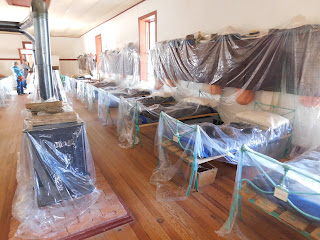Today we drove up to the Fort Davis National Historic Site, where the old fort had been established in 1854. The fort site was dedicated as a National Historic site in 1960.
Hoping to protect the garrison from winter northers, Smith tucked the fort into a canyon flanked on three sides by sheer rock walls. From 1854 to 1891, Fort Davis was strategically located to protect emigrants, mail coaches, and freight wagons on the trans-Pecos portion of the San Antonio-El Paso Road and the Chihuahua Trail, and to control activities on the southern stem of the Great Comanche War Trail and Mescalero Apache war trails.
Thanks to Wikipedia for the above information.
This is a description on the original layout if the fort.
As you can see the sheer rock walls surrounding one side of the fort.
The ruined walls behind the house would have contained the kitchen, which was separate from the main house because of fire danger.
This two story building was one of the officer's quarters. We noticed in one of the other officer's quarter buildings that the two quarters were separated by a hallway that ran completely through the building, called a "dog trot" in a conventional house.
This was Lieutenant's and Officer's Row. Each house could house two officers.
Fort Davis is important in understanding the presence of African Americans in the West and in the frontier military because the 24th and 25th U.S. Infantry regiments and the 9th and 10th U.S. Cavalry regiments, all-black regiments (known as the buffalo soldiers), which were established after the Civil War, were stationed at the post. Lt. Col. Wesley Merritt led Troops C, F, H, and I of the 9th Cavalry in reoccupying the fort on 29 June 1867.[2]:19 They rebuilt the fort, using limestone and adobe, outside the canyon walls.
This is one of the enlisted men's barracks that has been outfitted with uniforms, weapons and various military gear and equipment that was commonly used during the time. Everything has been covered with plastic due to the replacement of the roof recently.
Notice the wooden slats to support mattress that was about 1" thick.
If you're ever in this area, this is an attraction that you don't want to miss. It is not hard to imagine what it was like back in the late 1800's and the hardships that these men and some with their families went through. Enlisted men made $13 a month and if their wives went to work at the fort, she could earn $5-$10 per month. Keep in mind that these brave men protected the area for that much money and today, fast food workers flipping burgers demand $15 per hour! Enough rant...
So long.























No comments:
Post a Comment